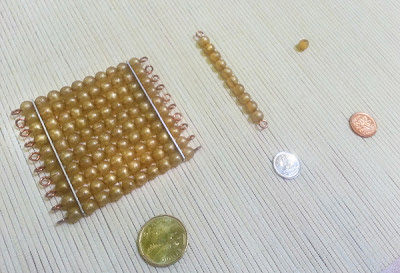
Montessori Practical Life Coin Activities: Money in the Montessori Classroom
You may begin introducing the children to the idea of money by adding coin-based activities to the practical life shelves. After learning names of coins using a three-period lesson, these three activities can be used with even the youngest children in the preschool environment.

A simple activity to develop the pincer grip is to put coins in a piggy bank.

Soak a few pennies in a salt and vinegar solution and then polish dry with a cotton swab.

Empty the piggy bank and sort the coins by type.

Older students can match Golden Bead material to coin denominations. Later, they can make different combinations of coins to match denominations. Making change with coins is an excellent extension to both the Montessori Stamp Game and the Bank Game.
Money can also be studied through geography. Pre-school children may learn about currencies from around the world as they study the continents. Lower elementary children begin to understand the differences between “needs” and “wants” as they learn about the fundamental needs of humans. And upper elementary students discover economic geography as they learn how a country’s wealth can be measured by their ability to buy, sell, and trade resources.
The idea of money demands social interaction. We must trade goods and services in exchange for money. Therefore, the best math activities are those which demand social interaction. After learning the names and denominations of money, as well as the concept of making change, students can use this new knowledge in real-world situations. Some Montessori teachers set up classroom stores while others make menus and have a classroom restaurant. Older students can plan going-out experiences that require them to earn money in order to pay for the trip. It is these real-life situations that ultimately help students master monetary concepts.
As much as possible, NAMC’s web blog reflects the Montessori curriculum as provided in its teacher training programs. We realize and respect that Montessori schools are unique and may vary their schedules and offerings in accordance with the needs of their individual communities. We hope that our readers will find our articles useful and inspiring as a contribution to the global Montessori community.
© North American Montessori Center - originally posted in its entirety at Montessori Teacher Training on Tuesday, May 14, 2013.
© North American Montessori Center - originally posted in its entirety at Montessori Teacher Training on Tuesday, May 14, 2013.

I like this post :) I have a couple fun uses that we have used in our homeschool that help teach the concept of using money, as well as money recognition and exchanges - http://www.nogreaterhonors.blogspot.com/2013/03/pantry-shopping.html , and this one - http://www.nogreaterhonors.blogspot.com/2013/03/money-money-money.html.
ReplyDeleteExcelente! En esto estoy nuevamente!
ReplyDeletethe smallest bill here in our country is 500, 1000, 2000, 5000, any suggestion how to apply this lesson
ReplyDeleteWith larger denominations,I would use the Montessori Golden Bead and Bank Game materials. For denominations of 500, you would use 5 Golden Bead 100-squares and for denominations of 1000s, you would use the Golden Bead 1000-cubes.
ReplyDelete